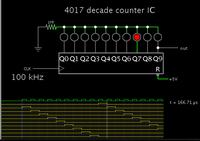TriggerHappy
Junior Member level 3

- Joined
- Sep 7, 2011
- Messages
- 30
- Helped
- 0
- Reputation
- 0
- Reaction score
- 0
- Trophy points
- 1,286
- Activity points
- 1,706
I want to measure two timing properties of my smartphone camera:
1) How long does it take for its rollings shutter to read an image top to bottom?
2) Exact how long time is there between the shutter openings of two specific consecutive photos?
For this purpose I thought I would build a binary counter with two rows LED's. One in the top of the field of view, the other simultaneous row of LED in the bottom of the field of view. I can then see on any image the time difference between its top and its bottom. And of course the time lapsed between two consecutive photos.
Since two photos could be taken a few seconds inbetween, I'd need about a 10 seconds interval of the slowest LED. And for the fastest LED I think 10 microseconds would be frequent enough. 10 s to ~9.5 us needs 21 LED:s. Times two for the second row. So I figure that I would need: 42 LED's, 42 wires, 42 resistors and two breadboards, and binary counters with 21 pinouts.
I imagine it would be a mess to put together practically! I'd need several counters cascading each other, and it is unlikely that none of the ~250 legs of the resistors and wires would come loose at any one time. Even if I scale down to the range 5s to 0.1ms, things only get moderately better.
How would you who are more experienced build such a temporary binary LED clock practically?
Even if I program an IC with 21 pinouts, it's still a mess.
1) How long does it take for its rollings shutter to read an image top to bottom?
2) Exact how long time is there between the shutter openings of two specific consecutive photos?
For this purpose I thought I would build a binary counter with two rows LED's. One in the top of the field of view, the other simultaneous row of LED in the bottom of the field of view. I can then see on any image the time difference between its top and its bottom. And of course the time lapsed between two consecutive photos.
Since two photos could be taken a few seconds inbetween, I'd need about a 10 seconds interval of the slowest LED. And for the fastest LED I think 10 microseconds would be frequent enough. 10 s to ~9.5 us needs 21 LED:s. Times two for the second row. So I figure that I would need: 42 LED's, 42 wires, 42 resistors and two breadboards, and binary counters with 21 pinouts.
I imagine it would be a mess to put together practically! I'd need several counters cascading each other, and it is unlikely that none of the ~250 legs of the resistors and wires would come loose at any one time. Even if I scale down to the range 5s to 0.1ms, things only get moderately better.
How would you who are more experienced build such a temporary binary LED clock practically?
Even if I program an IC with 21 pinouts, it's still a mess.



